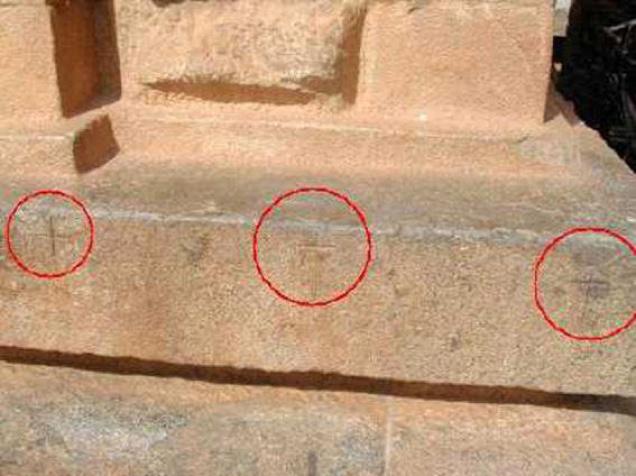
How many are familiar with weights and measures such as Kuzhi, Maa, Veli and Muntiri that were used in olden days?
(A monthly column that unravels fascinating facts about heritage, art and architecture, this one throws light on measurements used in medieval period)
Writing in the 19th Century, a British official complained, “the number of viss in a maund differs in a bewildering way, both according to local custom and to the substance which is being weighed… a ‘measure,’ is a most varying quantity – any old compressed beef tin of any size passes as a measure, if you will accept it. The only way is to get accustomed to your providers’ peculiarities and pay accordingly.” The same traveller would be surprised if he was in the medieval Tamil Nadu! Weights and measures from inscriptions are complex. They vary with region, dynasty and many kings created their own!
Different calculations
Weights and measures are frequently found in inscriptions that deal with gifts of land and produce to temples. The Chola and Pandya territories seemed to have had different measures but with many local variations. Some calculations can be made.
Land was measured in Kuzhi – which was one rod in length and one rod in width. Three Kuzhi made aMaa. 20 Maa made a Veli (sometimes called Sey as well). A Maa approximates to 33 cents. Because a rod length varied it’s difficult to say that a Veli in one part of the state was the same elsewhere. 1/80 of a Veli made a Kani and 1/320 of a Veli made a muntiri. Smaller land fractions went to as low as 2.81 sq.ft. Such small fractions were useful since land was taxed not just by spread but fertility as well. By colonial times, a Veli was equal to 6.6116 acres.
Grain was measured as eight Naazhi that made a pucca padi or a pattanam padi in the Pandya country. Surprisingly in Thanjavur, eight Naazhi made only half that quantity and was called a china padi. Amarakkal was used to measure grain. A Nerai Naazhi approximated to a little less than a kilo, possibly 850-900gms.
Gold and gems had a separate calculation. One gold kasu (coin) was four kunrimani (a seed). TwoKunrimani made a manjadi and 20 manjadi made a kalanju. 2.5 kalanju made a sovereign of pre-independence proportions, around eight grams today.
Land measures are most commonly encountered. Several temples such as those in Kanchipuram (Varadaraja temple), Srirangam and others have alavu kols – lines etched into the stone wall that are a measure for land. These come in varying lengths, 12, 16, sometimes even 18 ft. The ends are differentiated with a zig zag or some decorative feature, and the alavu kol, usually has a name to it. Raja Raja called his, Adavallan after the Chola tutelary deity Nataraja of Chidambaram. These measures continued even in the 19th centuries, temples in the Pudukottai district have such measures from the reigns of the Sethupathis. The Kols were based on a human span – (chaan) or a foot (adi). A rod was named after the number of spans and feet it comprised. 16 span rods were most common but mostly in the northern districts. Foot rods become more popular in the 12th century. The 18 foot rod was more popular in the Pandya country. We have evidence of land surveys being conducted during the reigns of Raja Raja I and Kulotunga and Jatavarman Sundara Pandya I in the 11-13th centuries. The person responsible for it, being honoured with the title “Ulagalanda” or one who surveyed the world.
In the 18th century, the documents in the Thanjavur Sarasvati Mahal library give us insights into the measures of that period. One Manjadi was 260 mg, One kalanju was 5.2 gms, One tank was One gm, One tola was 2.9 gms, One palam was 35 gms, Oneseer was 280 gms and One marakkal was three Kg. 12tolas made One palam (35 gm), eight palams made One seer (280 gm), five seers made One veesai (One kg and 400 gm), eight veesai made One manangu (11 kg and 200 gm), 40 manangu made One baram(448 kg).
In another system prevalent in the Maratha times One padi made 750 gm and four padis made Onemarakkal (three kg). This was used mostly for agriculture produce. Land was measured by a rod fourteen feet in length. 20 maa made one veli (6.5 Acres). 100 kuzhi made a maa. The Marathas also had taank (rhyming with ‘Monk’). One tola (three gm), in 1820, made three taank, whereas in 1780, One tola was equal to One taank. Gold and silver had a separate system. One kunrimani made 13.3 mg, two kunrimani made One manjadi (26.6 mg), 20 manjadi made One kalanju (5.320 mg), 60 kunrimanimade One poun (7.98 gm).
During the colonial times, measures included One padi, ½ padi and ¼ padi. Two aazhakku made ¼padi. ½ and aazhaku was a Veechampadi. Another unit was a Maakani. In Kumbakonam a ½ padi was a chinna padi. In many places down south liquids were sold as a Chombu– about 1/4th padi. Old timers still remember these units and can swiftly calculate and convert without modern devices – perhaps in some ways modern technology has made us mentally less agile!
(The writer can be contacted at pradeepandanusha@gmail.com)
source: http://www.thehindu.com / The Hindu / Home> Features> Friday Review> History & Culture / Stone Speak / by Pradeep Chakravarthy / Chennai – April 24th, 2014